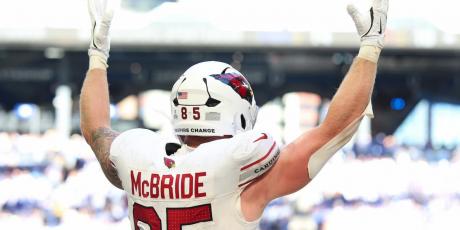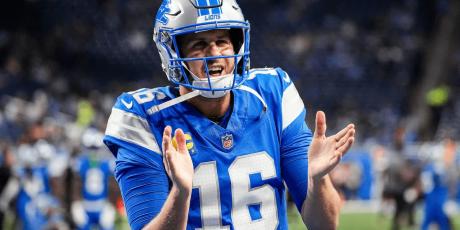NFL Draft Prospect Comparisons: Running Back
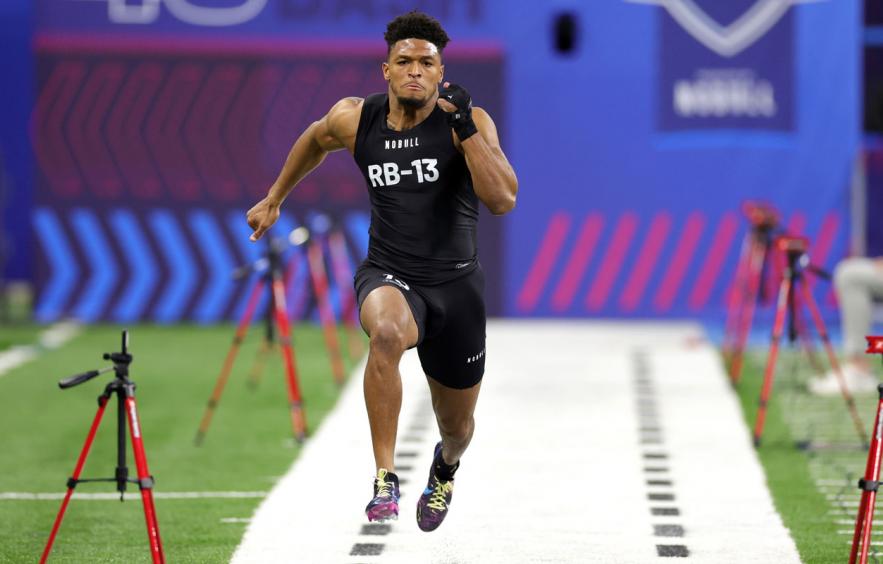
With the NFL combine now behind us, we have another piece of the puzzle filled in for prospect evaluations. While not every prospect participated in drills (or even attended the combine), those who did, have provided us with some valuable information. There were some players whose stock rose over the weekend while some players may have wished they didn't go to Indianapolis.
But, with this new data comes a new analysis. Last year, I wrote about college prospect profiles using only combine results, but this year I wanted to expand on that and get a more complete picture of who these players are. To do this, I use a technique called clustering, which allows me to bucket these players into a number of statistical profiles and compare one to another. In the clustering, I included a combination of production, efficiency, athleticism, and usage metrics in hopes of capturing who these players really are.
More NFL Draft and Rookie Content: Scott Smith's 2023 Mock Draft Version 1.0 | 11 Players Who Turned Heads at the NFL Combine | 10 Fantasy Relevant Rookies: A First Look | Connor Allen's 2023 NFL Mock Draft 1.0
This article will cover both the methodology that I used along with commentary on some of the standout players from the 2023 class. Draft season is in full swing!
Note: all college stats are for a player's full career in school.
Methodology
Before I get into the analysis, I want to explain the methodology and techniques that I used along with delineating what this analysis is and, more importantly, what it is not. Let's start off with the latter.
This analysis is a descriptive way to compare a player's college stats and athleticism to historical results. This is not a predictive indicator of future NFL and fantasy success or that a player with a similar combine result will have the same career.
In terms of the methodology, I used a Principal Component Analysis (PCA) using data since 2014. If you're unfamiliar with PCA, it is a way to "squish" several variables (in this case, each of our combine metrics), into just a couple of variables - our principal components - thus simplifying our dataset and reducing noise. Put another way, PCA helps us find fewer features that will represent our data in a more compressed way.
This also allows me to visualize the results on two axes using the first two principal components, which I wouldn't be able to do easily with the several combine metrics that we have. This is also where we'll be able to see player comparisons - players that appear further away from the center of the chart are more unique in their results and fall into a more distinct category.
For wide receivers, below are the weights for the combine metrics for each of the two principal components. To calculate a player's principal component, you can read these as linear equations. So for principal component one, a player's score is calculated as (-0.11*Touches) + (-0.52*Yards After Contact/Rush) + (-0.48*Breakaway %) + (-0.51*Missed Tackles Forced/Rush) + (-0.26*Missed Tackles Forced/Rec) + (-0.16*YPRR) + (-0.24*Dominator Rtg) + (-0.28*Relative Athletic Score).
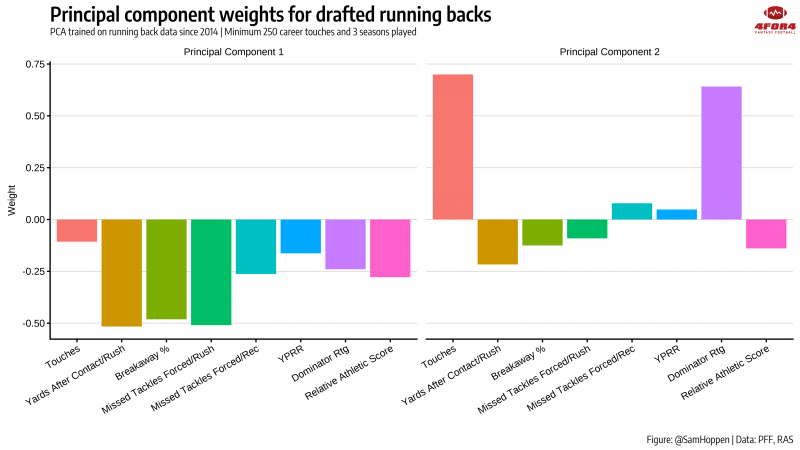
2023 Running Back Class Standouts
This year's running back class is highlighted by the oft-mentioned Bijan Robinson. But, there are a number of other solid options and diamond-in-the-rough players that make this one of the better running back classes in recent memory. The value of running backs in the NFL has clearly impacted the draft capital used on them recently, but there are sure to be a handful of Day 2 picks taken that could make an immediate impact on the field. Landing spot will drive a lot of these opportunities, but a lot of these players have traits that should make them shine from day one of their careers.
The chart below highlights some players for this year's rookie class (that I will further discuss) along with running backs drafted in the top 50 that were included in my sample.
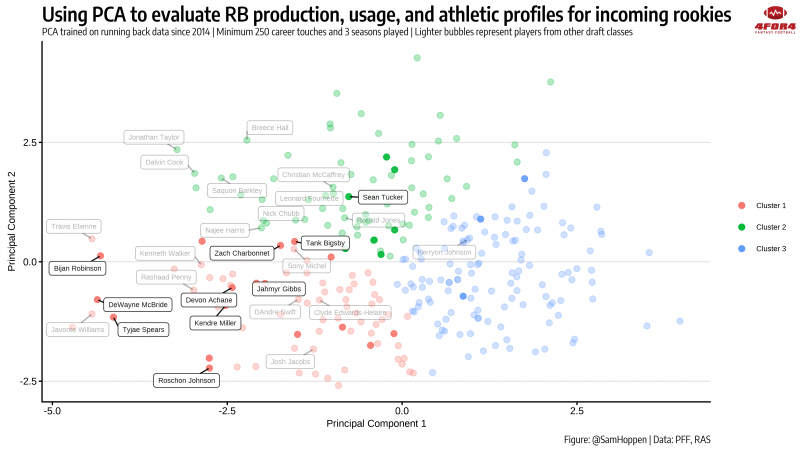
Bijan Robinson (Texas)
Bijan Robinson is, how they say, different. I don't need to run (pun intended) you through his accolades, but I'll do a quick overview anyway. First, Robinson's 9.81 Relative Athletic Score (RAS) currently ranks 32nd all-time (since 1987). As a rusher, he has been incredibly elite. Over the past two seasons, Robinson's 0.41 missed tackles forced per rushing attempt ranks first among 200 qualified running backs. Because of this, he's averaged 4.07 yards after contact per attempt. I mean, 4.07 yards per carry would be solid on its own, but he's doing this after he's contacted.
Not only has Robinson been mocked to teams in the first round of the draft, but also in the top 10 at times. I still find it hard to believe that sharp organizations like the Buffalo Bills or Philadelphia Eagles would spend that much draft capital on a running back, but I have seen crazier things in my life. In any case, Robinson is as sure a thing to excel at the next level as anything.
Comparable cluster profiles: Travis Etienne, Bryce Love
Jahmyr Gibbs (Alabama)
I firmly believe that the only reasonable comp for Jahmyr Gibbs is Alvin Kamara. From the way he glides across the field to the white tape on his arm, Gibbs seems like a (slightly smaller) spitting image of Kamara. Like Kamara, Gibbs is not a bruising back that will handle a massive rushing workload. This past year, Gibbs was given just under 13 carries per game with an average of 3.39 yards after contact per attempt (in the 58th percentile on the year, per PFF).
I mean, the balance he has when he takes contact is so impressive. Just reminds me of Kamara so, so much. pic.twitter.com/1xjVmTjVIs
— Sam Hoppen (@SamHoppen) March 7, 2023
But, where Gibbs excels most is as a receiver. In his final two years at Alabama, Gibbs posted an elite 2.30 yards per route run and forced a missed tackle on more than one of every three receptions he had. Some team is going to get an excellent weapon in their offense that can play multiple roles, and potentially at a full-round discount from Robinson.
Comparable cluster profiles: Tyler Allgeier, Elijah Mitchell
Zach Charbonnet (UCLA)
At 6'0" and 214 pounds, Zach Charbonnet is as close to the prototypical running back build as you'll see in this class and he showed that in his two years at UCLA (he transferred there from Michigan after his sophomore season). Charbonnet compiled over 1,300 rushing yards and 13 rushing touchdowns in each of his final two seasons. He's a bruising running back that will be solid on early downs and is as pure a rusher as any. The way he's able to cut upfield and find the right zones while slicing through arm tackles will make NFL coaches and general managers drool.
As far as Charbonnet's receiving talent, he had a career-high 37 receptions last year. Most of his receiving damage will be done out of the backfield as he only lined up in the slot or out wide on 5.7% of his snaps throughout his four-year career (per PFF). That's not necessarily a bad thing as that's how most backs in the NFL are used, but he'll likely need to be paired with a stronger receiving threat back at the pro level.
Comparable cluster profiles: Sony Michel, Nick Chubb
Devon Achane (Texas A&M)
Devon Achane is a speedster, there's no doubt about that. He ran a 4.32 40-yard dash this past Sunday with a 1.52 10-yard split, both of which are top-shelf marks. As a former track athlete, these numbers shouldn't be all that surprising, but it is one of his main selling points. Because of his speed, Achane posted an 11.4% breakaway rate in his college career.
It's a good thing Achane is fast because size leaves a bit to be desired. At 5' 9" and 188 pounds, Achane is on the smaller side, which is likely why he has garnered a number of Darren Sproles comparisons. Achane is confident that he's the best receiving back in the class, but his 1.16 yards per route run would suggest otherwise. His speed will be enough for a team to give him a shot at a solid role in their offense.
Comparable cluster profiles: Michael Carter, Ken Walker
DeWayne McBride (UAB)
Despite DeWayne McBride not competing in combine drills (due to a hamstring injury), he may be one of my favorite diamond-in-the-rough players that I mentioned for this class. His rushing metrics are as strong as they come in this class (yes, even on par with Robinson). Since 2020, McBride has forced 180 missed tackles, second only to Bijan Robinson. He has also totaled the fourth most rushes of at least 10 yards with 98. McBride has lost six fumbles over that span, but his vision on the field should make him easy to plug into any rushing scheme.
UAB RB DeWayne McBride's combination of vision and contact balance is elite
Top-5 RB on the @PFF board pic.twitter.com/KOqsJNTK12— Mike Renner (@PFF_Mike) March 7, 2023
Regrettably, McBride comes with a massive gap in his receiving ability. He recorded just five total receptions in his three-year career at UAB, something that will surely knock him down draft boards. This isn't to say that he can't turn into a valuable NFL running back - Nick Chubb only had 11 receptions in his final three seasons at Georgia. But, this could take him off the field in key passing situations as it has with Chubb.
Comparable cluster profiles: Javonte Williams, Rashaad Penny
Tank Bigsby (Auburn)
I mean, who wouldn't want to draft a running back whose first name is Tank? His name, though, isn't the only reason that he's on this list. Bigsby burst onto the scene as a freshman, leading Auburn's backfield with 846 rushing yards in a COVID-shortened season, and followed it up with a 1,100-yard season as a sophomore.
He did show some flashes as a receiver and is quite fluid with his movements, but only averaged a measly 0.86 yards per route run. Additionally, while his 4.56 40-yard dash time at the combine wasn't all that impressive, his 1.54-second 10-yard split was in the 80th percentile, which is good enough to not hurt his draft stock that much. He'll likely be a Day 3 pick that a team uses to add depth to their backfield.
Comparable cluster profiles: Zonovan Knight, Sony Michel
Tyjae Spears (Tulane)
What do the band Chumbawamba and Tyjae Spears both have in common? They were both one-hit wonders. That may be a bit harsh for Spears, but he amassed just 1,322 rushing yards and 12 rushing touchdowns in his first three years at Tulane before totaling 1,594 yards and 19 touchdowns in his senior year. This is partly due to him tearing his ACL three weeks into his sophomore season.
But, Spears does have some redeeming qualities. Despite the injury, Spears has shown an ability to make jump cuts and produce explosive runs to the tune of a 10.6% breakaway run rate (per PFF). He's also extremely elusive as a receiver, forcing a missed tackle on two of every three receptions in his final two years in college. The injury and smaller stature will likely make Spears a Day 3 pick in the draft, but he's one of these diamond-in-the-rough players that could serve a very valuable role to a contending team.
Comparable cluster profiles: Javonte Williams, Darrell Henderson
Kendre Miller (TCU)
I can picture it now: it's Sunday Night Football and Cris Collinsworth comes back from break and exhales with, "Now here's a guy who grinded his way to the league." It would, of course, be in reference to Kendre Miller. Miller steadily improved throughout his three-year career at TCU to finish off with 1,500 total yards in his last year. In that way, Miller is very similar to Tyjae Spears. Last season, Miller also recorded a 9.5% explosive run rate, the third-best among the players in this class. He was also very light on his feet in college which helped contribute to his 0.31 forced missed tackles per rush.
Miller wasn't able to participate in combine drills due to an MCL injury, which could also prevent him from testing at TCU's pro day. Miller also has some work to do in improving his pass-protection skills. Ultimately, Miller will be another Day 3 pick in the draft that could fit in the right scheme.
Comparable cluster profiles: Trey Sermon, Kennedy Brooks
Sean Tucker (Syracuse)
Sean Tucker was another player who did not test at the combine last week (he only got measured). And from a statistical standpoint, I'm not sure what gets people excited about Tucker. As the kids would say, his college stats are very "mid." He didn't reach the 75th percentile in any of the major statistical categories (missed tackles forced per rush, yards after contact per rush, yards per route run). His saving grace is his accumulation stats in that he amassed 1,300 total yards in his final two seasons and declared early as a 20-year-old. If someone can provide me with some other evidence to suggest that he's a good prospect, I'm all ears. But until then, he would be near the end of my hypothetical rankings.
Comparable cluster profiles: Ronald Jones, Eno Benjamin
Roschon Johnson (Texas)
Roschon Johnson was (rightfully) overshadowed at Texas by the aforementioned Bijan Robinson. That said, Johnson is no scrub himself. Johnson never topped more than 600 rushing yards in a season in his four years at Texas but was very efficient doing so. Per Chris Spags, Johnson averaged 0.556 EPA per play and a 6% stuffed rate (hit at or behind the line of scrimmage) when facing 8-man fronts.
He also offers value in ways that typically only show up on tape. His pass-protection skills could keep him on the field in 3rd-down situations at the next level. Additionally, he has the speed and burst that will allow him to break off long plays and leave defenders in the dust.
Comparable cluster profiles: Boston Scott, Ty Johnson


